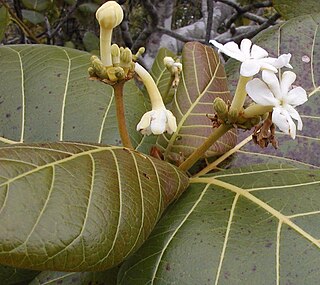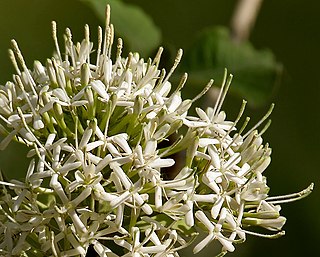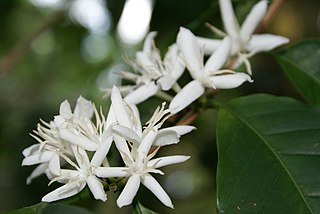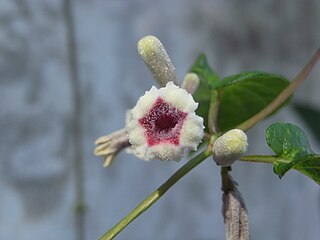
Guettardeae is a tribe of flowering plants in the family Rubiaceae and contains about 748 species in 14 genera. Its representatives are widespread geographically and are found in the tropics and subtropics.
Myrmephytum is a genus of myrmecophytic flowering plants in the family Rubiaceae. It is distributed from central Malesia to New Guinea.

Squamellaria is a genus of myrmecophytic flowering plants in the family Rubiaceae. It includes eight species native to the Solomon Islands, Vanuatu, and Fiji.

Rubioideae is a subfamily of flowering plants in the family Rubiaceae and contains about 7600 species in 27 tribes.

Knoxieae is a tribe of flowering plants in the family Rubiaceae and contains about 131 species in 16 genera. Its representatives are found in Tropical and Southern Africa, the islands in the Western Indian Ocean, the Arabian Peninsula, Tropical and Subtropical Asia, and Northern Australia.

Morindeae is a tribe of flowering plants in the family Rubiaceae. The tribe contains about 165 species in 5 genera, found mainly in the tropics and subtropics.

Spermacoceae is a tribe of flowering plants in the family Rubiaceae and contains about 1346 species in 57 genera. Its representatives are found in the tropics and subtropics.

Pavetteae is a tribe of flowering plants in the family Rubiaceae and contains about 624 species in 9 genera. Its representatives are found from the tropics and subtropics of the Old World and the southern Pacific region.

Gardenieae is a tribe of flowering plants in the family Rubiaceae and contains about 586 species in 53 genera.

Coffeeae is a tribe of flowering plants in the family Rubiaceae and contains about 333 species in 11 genera. Its representatives are found in tropical and southern Africa, Madagascar, the western Indian Ocean, tropical and subtropical Asia, and Queensland.

Octotropideae is a tribe of flowering plants in the family Rubiaceae and contains about 103 species in 18 genera. Its representatives are found in the paleotropics. The genera previously placed in the tribe Hypobathreae are now placed in Octotropideae.

Dialypetalantheae, synonym Condamineeae, is a tribe of flowering plants in the family Rubiaceae and contains about 305 species in 31 genera. Most genera are found in Central and Southern Tropical America, but a few occur in Southeast Asia.

Sabiceeae is a tribe of flowering plants in the family Rubiaceae and contains about 164 species in 7 genera. Its representatives are found in tropical Africa, Madagascar, Sri Lanka, and from Mexico to tropical America. The genus Sabicea is one of the rare genera in Rubiaceae that occurs both in tropical Africa and tropical America.
Cordiereae is a tribe of flowering plants in the family Rubiaceae and contains 124 species in 12 genera. Its representatives are found in central and southern tropical America.

Posoquerieae is a tribe of flowering plants in the family Rubiaceae and contains 23 species in 2 genera. Its representatives are found from Mexico to tropical South America.

Paederieae is a tribe of flowering plants in the family Rubiaceae and contains 81 species in 4 genera. Its representatives are found in the tropics and subtropics.

Urophylleae is a tribe of flowering plants in the family Rubiaceae and contains 237 species in 6 genera. Its representatives are found in the tropics.

Coussareeae are a Neotropical clade of morphologically heterogeneous plants in the subfamily Rubioideae of the coffee family (Rubiaceae). The tribe encompasses about 330 species assigned to ten genera: Bradea, Coccocypselum, Coussarea, Cruckshanksia, Declieuxia, Faramea, Heterophyllaea, Hindsia, Oreopolus, and Standleya. Historically, the genera of Coussareeae have rarely been considered closely related, and the widely defined Coussareeae were delimited based on molecular systematics without proposed morphological synapomorphies.
Palicoureeae is a tribe of flowering plants in the family Rubiaceae and contains about 817 species in 11 genera. Its representatives are found in the tropics and subtropics.
















